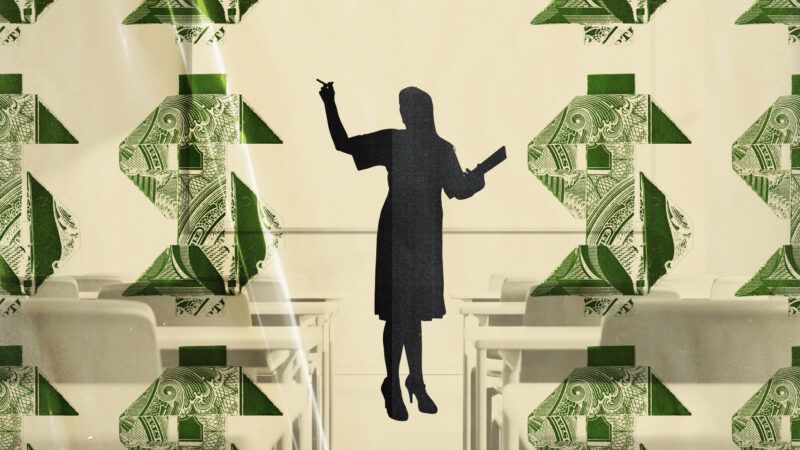Are Teachers Really Underpaid?
The answer is more complicated than you might think.

Teachers are underpaid, right? It's a near-universally repeated maxim. Kamala Harris thinks so. So does Betsy DeVos. However, the reality is a bit more complicated.
For the 2023–24 school year, the average public school teacher salary was just under $70,000—well over the average for bachelor's degree graduates ages 25 to 34 (though many teachers have master's degrees).
West Virginia paid teachers the least, at around $52,000 per year, while California paid them the most, with an average salary of over $95,000. According to the National Education Association, teacher salaries top out at over $100,000 in 16.6 percent of districts. However, salaries have generally stagnated. From 2002 to 2020, inflation-adjusted teacher salaries declined by 0.6 percent while as per-pupil spending increased.
The reality is that teacher salaries vary widely between states and districts, especially when looking at pay adjusted for the cost of living, making it difficult to make generalizations. Adding to the murkiness, pay doesn't seem to motivate teachers as much as many people think.
According to a December 2023 report from the National Center for Education Statistics, when public school teachers were asked why they decided to leave the profession, only 9.2 percent said it was because they needed higher pay.
A study from earlier this year also concluded that, among teachers who choose to leave their jobs, most don't earn more in their new position. "The median employed leaver makes less than before they left teaching and their earnings do not recover nearly a decade after exit," reads the study by University of Chicago and University of California, Irvine researchers. "These broad trends…suggest that factors other than earnings may have contributed to exit decisions for the average leaver."
"In other words, the economic argument around the teacher pay gap has some holes," wrote education reporter Chad Aldeman last week in an analysis of this and other studies looking at teacher compensation. "Ironically, the political and media attention focused on teacher wage gaps may also be contributing to a sense that teachers are paid less than they actually are. People tend to underestimate how much teachers actually earn, and that could discourage would-be educators from considering the profession in the first place."
But if politicians still really want to increase teacher pay, the typical measures—hiking taxes and increasing per-pupil spending—don't seem to get the job done. While school spending has markedly increased over the past 20 years, teacher salaries have barely budged. This extra spending has primarily gone to hiring more administrative staff—and it hasn't exactly resulted in better student results.
"It appears that the biggest driver is school districts hiring more people, but not primarily new classroom teachers," Neal McCluskey, director of the Center for Educational Freedom at the Cato Institute, tells Reason. "The biggest relative growth has been in 'instructional aids' who assist teachers in the classroom. While teachers were 53.4 percent of all public school system employees in 1990, they were only 47.5 percent in 2022. Aides rose from 8.8 percent of employees to 13.3 percent. It's not clear why this occurred, but it could be teachers asking for help, regulations requiring more services for kids, or lots of other possible factors."
Whether teachers are underpaid isn't an easily answered question. But if you want to know why your local public school teachers aren't getting paid more, the answer might just lie in the influx of nonteachers on the district payroll.


Show Comments (101)